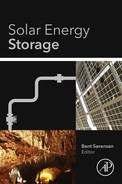Consumer Perceptions and Acceptance of PV Systems with Energy Storage
Naoya Abe1; Junichiro Ishio1; Teppei Katatani1; Toshihiro Mukai2 1 Department of International Development Engineering, Tokyo Institute of Technology, Tokyo, Japan
2 Central Research Institute of Electric Power Industry, Tokyo, Japan
Abstract
The purpose of this chapter is to illustrate consumer perceptions and acceptance of photovoltaic (PV) systems with energy storage systems (ESS) in Japan. In order to describe the situations around the consumers, we first reviewed the ongoing dynamism of Japanese energy policies and the technological advances regarding the impacts of the Great East Japan Earthquake. Based on this, we distributed questionnaires and collected 1397 answers from residents in Fukushima, Kanagawa, and Kochi prefectures. According to the respondents, we clarified that the perception and attitudes related to ESS are still weak and in the early stage; however, many current residential PV owners show relatively high interest in ESS, and thus the combination of the two systems could become something like “bread and butter” in the future.
12.1 Background
This chapter will illustrate consumer perceptions and acceptance of photovoltaic (PV) systems with energy storage in Japan. Though this dual-system combination is not yet common, the product appears set to grow in the near future. Because energy storage systems (ESS) are not common at the residential level, the significance of ESS for consumers is appropriately understood in conjunction with energy policy—more specifically, renewable energy policy and its related subsidy schemes. Because Japan experienced a serious nuclear power plant accident in Fukushima on March 11, 2011, Japanese energy and renewable policies cannot be discussed without inquiring how and for what electricity should be generated, though the energy policy itself has not changed dramatically since the Fukushima accident (Kurokawa, 2014). Dr. Kiyoshi Kurokawa was appointed by the National Diet and led the investigation of the nuclear power plant accident, and criticizes the current state of the Japanese energy policy.
As of June 2014, more than 3 years have passed since the Great East Japan Earthquake, the consequent tsunami, and the Fukushima Daiichi nuclear power plant accident. Those severe events resulted in consequences including forced evacuation, “temporary” relocation, and planned outages (rolling blackouts). These inconveniences were further highlighted by the loss of taken-for-granted conveniences such as refrigerators, televisions, and/or air conditioners, among others. Reasonably, those impacts in turn strengthened interest in renewables and related technologies among those who were directly and indirectly affected by the accident. At the same time, however, it could also be the case that some people are no longer vividly conscious of the accident and its impact, simply using electricity as a taken-for-granted service, as before.
The general attitude toward and recognition of energy policy and renewables after March 2011 can be partially confirmed through a survey by NHK (2013). The survey revealed that about 67% of the 2536 respondents thought renewables should be promoted in the coming years. The survey also indicated that if the price of electricity increased due to the reduction of the number of nuclear power plants, then about 50% of the total respondents would not desire that policy. Reasonably, the general attitude toward and perception of the energy policy was influenced not only by the accident, but also by the realistic costs associated with changes to the policy.
Notably, while the number of installed residential PV systems was increasing before the accident in Fukushima, the accident also triggered accelerating sales in Japan, which will be discussed further in Section 12.2. The rapid increase of installed PV generating capacity, however, does not necessarily mean that there is an appropriate understanding of the system and its potential risks. Mukai et al. (2011), for example, found that residential PV owners in a Japanese municipality did not know about its possible failure and its consequent influence on profitability, which is often emphasized by retailers and manufacturers. This is partly due to the fact that residential PV manufacturers emphasize the positive aspects of the system and substantially neglect the negative aspects of their products. The same could be the case for residential ESS, so an investigation into how people think of ESS is worthwhile. Consumers should understand both the positive and negative aspects of energy-saving products.
For individuals looking to reduce their dependency on grid-oriented electricity in Japan, the choices have been relatively limited and the systems have been quite expensive in the past. Among the available options, the residential gas-based fuel-cell system (cogeneration system for electricity and heat, called “Ene-Farm,” to which subsidy has been provided by the Japanese government since 2009) has been the most significant and realistic option. However, its diffusion is limited mainly by its high cost and the space required to house the system; Japanese urban residential areas are extremely densely populated, and each household is restricted in size, meaning that many households cannot spare the space for the equipment.
In April 2013, a Japanese firm called ONE Energy, a joint venture established by three Japanese companies (i.e., ORIX, NEC, and EPCO; http://www.orix.co.jp/grp/en/news/2013/130425_ORIXE.html), began offering to install a lithium-ion (Li-ion) storage battery with 5.53 kWh capacity for detached houses and renting the system to customers, which in turn allows customers to use the system at an affordable price (ORIX, 2013). The combination of residential PV systems and residential electricity storage batteries could be the most plausible option for many Japanese households in the future, if prices continue to fall. However, the general public interest and perception of residential ESS is not well known. This chapter aims to shed light on this aspect.
This chapter consists of the following sections: Section 12.2 offers a brief sketch of Japanese energy policies, including the feed-in tariff (FiT). Section 12.3 briefly outlines the current use of ESS in Japan, followed by the results of a survey of consumers’ perceptions and knowledge of renewable technologies, including electricity storage.
12.2 Japanese Energy Policy, Including FiT
A turning point in Japanese energy policy and industry occurred in 2011. Indeed, a law on the FiT for renewable energy sources (RES) went into effect (Ministry of Economy, Trade, and Industry (METI), 2011) after the earthquake and consequent disasters. Furthermore, the Japanese METI has promoted liberalization of the electricity market to improve power exchange across regions as well as to increase renewable energy generation capacity by creating full retail-sector competition and unbundling the generation, transmission, and distribution sectors (METI, 2013a). Notably, the current administration assumes nuclear power as one of the main sources of energy in Japan, which has caused complicated discussions in terms of necessity, safety, and legitimacy.
When we focus on the historical trend of residential-level renewable energy diffusion in Japan, substantial installation started in 1974, with gradual increases in the number of installed systems. Notably, the number of residential PV system owners has increased sharply after 2011, triggered not only by the natural and human-made disasters in Fukushima, but also by economic incentives from the Japanese FiT scheme introduced in 2011. According to statistics provided by Japan’s Agency for Natural Resources and Energy, as of March 2011, the accumulated installed generation capacity for the residential sector was about 4700 MW. After the FiT scheme took effect in July 2012, the newly added capacity as of March 2014 is about 2688 MW (approved) and 2276 (in operation), indicating how fast the total national capacity of residential PV systems has expanded (METI, 2014).
In Japan, the “Sunshine Project” in 1974 (Ikeda, 2013) marked the initial development of substantial renewable energy policies. The project, triggered by the oil crisis in 1973, aimed to encourage the research and development of alternative energy technologies. Afterward, in 1980, the Act on the Promotion of Development and Introduction of Alternative Energy set national targets for the amount of power supplied by alternatives, aiming to reduce dependence on oil by developing and introducing new energy sources (Ikeda, 2013) because Japan imported (and still imports) the majority of its energy sources from abroad.
Since the 1990s, RES have gradually increased, beginning mainly as pilot projects in various local municipalities because utility companies voluntarily purchased surplus electricity generated from renewable energy. This was furthered by a grant (subsidy) scheme introduced by the New Energy and Industrial Technology Development Organization (NEDO), a government research and development funding agency in Japan (Ohira, 2006; Suwa and Jupesta, 2012; Kaizuka, 2012). Nevertheless, renewables (i.e., solar PV and wind) experienced lower adoption rates compared to other alternatives to oil, such as nuclear, natural gas, and coal energy. Hence, the Act on Special Measures for the Promotion of New Energy Use was enacted in 1997 to encourage further diffusion of RES to fulfill targets set in 1980.
The Act on Special Measures Concerning New Energy Use by operators of electric utilities, also known as Renewable Portfolio Standards (RPS), took effect in 2003. This law obliges utility companies to produce and/or supply a certain amount of electricity from RES, including hydropower (less than 1000 kW), solar PV, wind, biomass, and geothermal. Practically speaking, the act requires the power company to generate 1.35% of its total electricity from renewables in 2010. When the RPS targets in other countries are considered, such as the United Kingdom (10.4% of total power supply in 2010), Italy (3.05% of total power supply in 2006), Australia (3.8% of total power supply in 2010), and Sweden (16.9% of total power supply in 2010), their figures are more ambitious (Ohira, 2006). Prices charged to utility companies for energy from RES were at the time relatively low (e.g., JPY 24/kWh from solar PV, and approximately 10 ¥/kWh from wind power), thus the policy was not beneficial for power producers.
The partial FiT scheme, which requires utility companies to purchase electricity at JPY 48/kWh from residential PV systems and JPY 24/kWh from nonresidential PV systems, went into effect in 2009 with the Act on Sophisticated Methods of Energy Supply Structures. These prices are fixed for the next 10 years, though they exclude facilities with a capacity greater than 500 kW. Other than the purchase price (almost double that of the previous scheme), the general structure was the same as that of the subsidy policy for residential PV systems effective between 1994 and 2005 (Myojo and Ohashi, 2012; Kaizuka, 2012).
The Act on Special Measures concerning the Procurement of Renewable Electric Energy by Operators of Electric Utilities (METI, 2010) was enacted in August 2011. This energy policy scheduled cabinet approval on March 11, 2011—before the earthquake occurred, by curious coincidence—and became effective in July 2012 (Esteban and Portugal-Pereira, 2014), establishing the “full” FiT scheme. Table 12.1 describes the tariffs and duration for each RES as of 2014. The share of electricity from renewables in the total electricity consumed remained at only 1.6% in 2012, implying that a further diffusion of renewable energy in Japan could be expected. It is also notable that the price of solar PV has decreased since the inception of the FiT in Japan.
Table 12.1
Tariffs (¥/kWh) and Duration (Years) of Renewable Energy Sources in Japan
| Energy Source | Tariff | Duration |
| Solar PV | ||
| 10 kW or more (2012 → 2013 → 2014) | 40 → 36 → 32 | 20 |
| Less than 10 kW (2012 → 2013 → 2014) | 42 → 38 → 37 | 10 |
| Wind power | ||
| Onshore, 20 kW or more | 22 | 20 |
| Onshore, less than 20 kW | 55 | 20 |
| Offshore | 36 | 20 |
| Small- and medium-scale hydropower | ||
| 1- 30 MW | 24 | 20 |
| 200 kW-1 MW | 29 | 20 |
| Less than 200 kW | 34 | 20 |
| Geothermal power | ||
| 15 MW or more | 26 | 15 |
| Less than 15 MW | 40 | 15 |
| Biomass | ||
| Biogas | 39 | 20 |
| Wood-fired power plant | ||
| Timber from forest thinning | 32 | 20 |
| Other woody materials | 24 | 20 |
| Recycled wood | 13 | 20 |
| Waste, excluding woody waste | 17 | 20 |

Adapted from “Tariffs and duration of feed-in tariff in Japan” by the Agency of Natural Resources and Energy (2014).
Note: FiT requires utility companies to purchase only surplus electricity of solar PV whose capacity is less than 10 kW.
12.3 ESS in Japan
The massive earthquake, nuclear power plant accident, and consequent blackout focused serious attention on the fundamental role of and high dependency on electricity for those who live not only in the affected areas, but also in other areas, including the greater Tokyo region. Partially because the impact of the nuclear power accident was so serious, many people came to believe that renewable energy would be the main power generation option pursued in the future. Some also seriously started considering PV systems and other stand-alone technology as a backup source of energy for natural-disaster-related grid power failures. In terms of backup systems, general public awareness of electricity storage could have increased, but the magnitude of awareness is unknown. This part of the book aims to clarify this point.
In Japan, the development of Li-ion and nickel-metal hydride batteries have advanced for use as batteries for plug-in hybrid electric vehicles (PHEVs) and electric vehicles (EVs), which could also supply power in an emergency, to some extent.
Additionally, on the power supply side, some institutions have conducted demonstration tests of bulk energy storage with generally more than 1 megawatt power output. These include sodium-sulfur (NaS) and redox flow batteries, in addition to Li-ion and lead-acid batteries, to compensate for the intermittent nature of renewable energy, which depends on climate conditions, and for load leveling and peak shaving of micro-grids on isolated islands (Ishida et al., 2012; Kawakami et al., 2010; Shigematsu, 2011; Tamaki et al., 2012).
On the demand side, the need for more RES and the usefulness of energy storage as an emergency power supply, realized after the disaster, have raised awareness of ESS for households and businesses. Besides ESS, a succession of new products to address these needs have appeared on the market, including the “smart house,” equipped with residential PV systems, energy storage, and home energy management systems (HEMS).
Presently, households mainly use Li-ion and lead-acid batteries as an emergency power source and to save power with PV systems. Most of the Li-ion batteries have a capacity between 1 and 15 kWh and cost between JPY 700,000 and JPY 2,000,000. Although ESS are initially expensive, one can receive a subsidy for certain Li-ion storage systems of one-third of the expenditure, up to JPY 1 million, as of 2014 (Sustainable open Innovation Initiative, 2013; METI, 2013b). Simultaneously, some municipalities provide grants (approximately JPY 100,000: about $1000 if $1 = JPY 100) for those who purchase energy storage. As another option, PHEVs and EVs generally carry batteries with a capacity ranging from 5 to 10 kWh, and 15 to 25 kWh, respectively. Their prices range between JPY 3 and 4 million.
Figure 12.1 illustrates various types of batteries based on system power ratings and discharge time. Among them, the general public could recognize the battery storage system through some actual products and familiar devices such as hybrid car batteries (a), automobile starter batteries and uninterruptible power supply (b), EV batteries, portable batteries for tablets and smartphones, and residential electricity storage systems (c).

Toyota (2012) conducted an Internet-based survey of electricity consumers to analyze how the awareness of energy on the demand side changed after the calamity. In the survey, more than half of the 500 total respondents answered the top two in five categories (strongly agree and agree) to the statement that it is necessary to install energy storage for an emergency, and that one prefers to purchase energy storage for one’s own house. The results of the survey suggest the need for distributed generation systems.
Goto and Ariu (2012) also investigated consumers’ preferences for residential PV systems after the earthquake. They analyzed the purchase intentions for residential PV systems using contingent valuation methods, and calculated the willingness to pay for an emergency power supply by installing energy storage with a PV system. From the 2663 valid responses, consumers placed an estimated value of about JPY 1,180,000 on a half-day supply of electricity from a battery in an emergency. The results indicate a high level of consumer interest in power supply in the event of a calamity. Please note that Goto and Ariu (2012) further discussed why consumers demonstrated a significantly high willingness to pay for the PV and storage technologies, pointing out three main reasons. First, the respondents may have a potentially stronger motivation to mitigate disaster-related risk, because the survey was conducted right after the March 2011 earthquake and tsunami. Second, they may hold exaggerated expectations for the capacity of storage technologies provided at the time of the survey. Finally, the willingness-to-pay options in the survey are relatively higher than in reality, on average. For more details of their discussion, please refer to Goto and Ariu (2012), written in Japanese.
A Japanese company specializing in homes with solar PV and smart homes, Sekisui Chemical Co., Ltd., and its research institute, EnviroLife Research Institute, Co., Ltd., administered surveys in January 2011 (before the disaster), July 2011 (after the disaster), and January 2013 to the tenants of their houses with solar PV systems. The survey carried out before the disaster investigated the changes in attitudes to energy usage through PV, and gained 1226 valid replies from those who moved into their houses in 2009 (Sekisui, 2011a). In July 2011, after the earthquake, they administered a follow-up survey of the respondents from the previous investigation (Sekisui, 2011b), but focused more on the changes in awareness of energy usage due to the disaster. From 716 valid replies, 34% indicated a keen interest in energy storage, 57% had an interest, and the remaining 9% indicated that they had no interest at that time.
In January 2013, the companies administered a similar survey, aiming to investigate changes in consumer awareness, targeting tenants who occupied houses with residential PV systems in 2011 (Sekisui, 2013a). This inquiry also asked about batteries, as in the previous examination. According to the report, from 1097 valid responses, 40% replied that they had a keen interest, 54% had an interest, and the remaining 6% indicated no interest, which suggests an increase in concerns about backup energy, compared to 2011.
In August 2013, the companies conducted another investigation, targeting those living in smart homes equipped with residential PV, energy storage (5.53 or 7.2 kWh), and HEMS from September 2012 to March 2013 (Sekisui, 2013b). This study aimed to understand the actual usage and consumers’ satisfaction with the use of energy storage in their homes. In terms of satisfaction related to battery usage, 44% indicated that they were very satisfied, 43% were fairly satisfied, 10% did not say either way, 3% answered somewhat dissatisfied, and there were no answers of very dissatisfied from 115 valid respondents. These consumers answered that the ability to reduce monthly electricity expenses and access to an emergency power supply were the features providing satisfaction with owning energy storage.
Tagashira et al. (2012) investigated consumer intentions to purchase home storage batteries through a survey in November 2011. The survey revealed that consumers recognized the advantages, including access to electricity in an emergency, and reduced electricity costs from using grid-generated power at night rather than during the day. However, they also recognized the requirement to use an electricity plan offering comparatively expensive daytime rates to qualify for less expensive evening rates as a disadvantage—a purchase disincentive. Users reported that they had purchased their storage batteries to gain the stated advantages. In the question asking about the desire to purchase energy storage, outlining some patterns of initial costs and the potential gains over the estimated useful life of the battery, a majority of respondents made it a purchase condition that the initial cost be recoverable.
12.4 Consumer Perception Survey: Renewables and ESS in Japan
12.4.1 Background
It is assumed that people’s attitudes toward and perceptions of ESS are influenced by the characteristics of the geographical location in which they live. This is mainly because many local municipalities promote renewables, and many actually provide various types of assistance to promote purchases, notably of PV systems. Indeed, when considering the characteristics of each local area, the ongoing aging and depopulation trend in Japan should be taken into account, because if an area has few or no people, there is not much sense in a discussion about consumer perceptions. In addition, the relative benefits and costs that people associate with these systems would vary, influenced by this demographic trend, making it a trend worth examining.
12.4.2 Objective and Design of the Survey
An Internet-based survey was conducted in March 2014. The groups of people surveyed were residents in three areas: Fukushima, Kochi, and Kanagawa prefectures. These areas were chosen based on careful selection criteria meant to include and represent the current aging and depopulation trends in Japan.
Each of the three prefectures characterizes the current issues in Japan. Fukushima prefecture is well known as the area suffering massive losses from the tsunami and nuclear power plant accident, which still forbids access within a 20 km radius of the plant. It has been 3 years since the disaster, but the area still suffers economically and socially. To accelerate the reconstruction and revitalization of the affected areas, the federal and local governments have launched many initiatives, including the Fukushima Revival Plans (Plan for Revitalization in Fukushima Prefecture), which clearly state that they should abandon nuclear power in favor of robust decentralized generation systems based on RES. Therefore, it is assumed that the residents in Fukushima could have a relatively strong intention and motivation to install various RES-oriented technologies, such as residential PV and ESS. Kochi prefecture is representative of rural depopulated and aging areas in Japan. Except for those prefectures where heavy snowfall is common, Kochi prefecture and Fukushima prefecture have the highest depopulation rate following the disaster, and thus a comparison of the responses from residents in both Kochi and Fukushima could be of interest. Kanagawa prefecture, part of the greater Tokyo region, is representative of Japan’s urban areas. While depopulation is creating serious effects in many rural prefectures in Japan, Kanagawa prefecture does not have any depopulating subareas in its jurisdiction, and income levels are generally relatively higher than those of the other two prefectures. These representative areas were selected to investigate the ownership characteristics of storage battery systems in Japan.
In total, 1397 answers were collected: 484 from Fukushima, 477 from Kanagawa, and 436 from Kochi. Among the samples, there are no significant disproportions in the sample attributes. The respondents are between 20 and 69 years old.
12.4.3 Awareness of Storage Battery Systems
Figure 12.2 illustrates the awareness of ESS in Japan. At least 90% of respondents have heard of them; however, the number of people who know what they are is less than half. To better understand these figures, we compared them with knowledge of the other types of residential RES, shown in Figure 12.3.

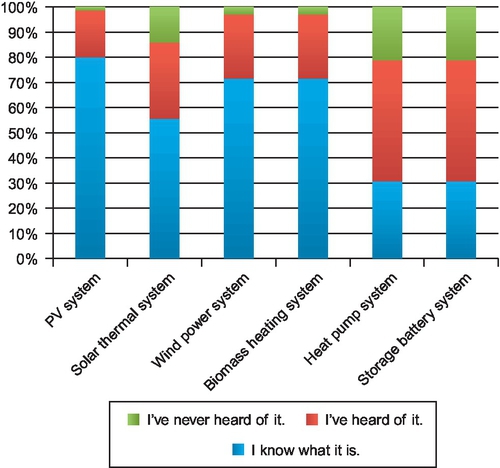
Compared to the other technologies, awareness of heat pump systems and storage battery systems is relatively low. On the other hand, awareness of PV systems is much higher, with only a few people having never heard of them, and about 80% of respondents knowing what they are.
We can conclude that almost everyone has heard of ESS, but detailed information about what these are has not been shared to the same extent as for PV systems.
12.4.4 Installations of Electricity Storage Systems
Figure 12.4 shows the current ownership and future installation intentions for storage batteries. Only 11 respondents have one installed, and 13% of respondents have plans to install one. However, more than half of respondents do not intend to install a storage battery system within the next 5 years. The rest could not clearly state their future ownership intentions because, as Figure 12.2 shows, they do not know enough about the technology to make an installation decision.
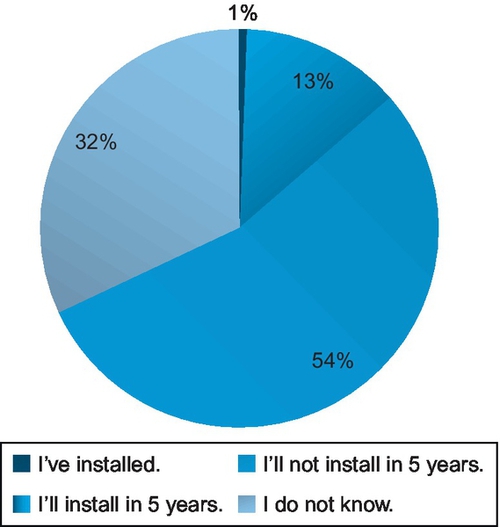
12.4.5 The Relationship Between Electricity Storage Systems and PVs
Generally, residential ESS should provide their owners with electricity during a power outage, while saving the owners money on their monthly utility bills. If a resident installs both a storage system and a PV system, the home electricity supply system is robust, further reducing reliance on peak usage. Some expect synergistic effects from storage batteries and a PV system, and install both in their homes. Figure 12.5 shows the current state of installations and intentions, demonstrating that the owners or future owners of PV systems tend to also install storage battery systems, compared to non-PV owners.
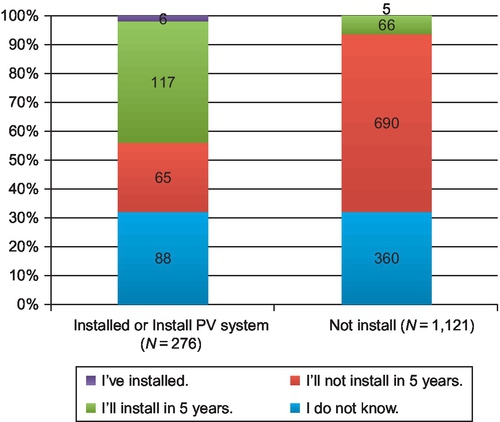
Table 12.2 shows a detailed description of the current installations. The number of respondents who use a storage battery alone is 56, though the number of residents who intend to use both an energy storage and a PV system is 123 out of 1397 respondents. Of the 123 respondents, about 71% (87 respondents) indicated that they will install both systems. This result implies that more people assume that the combination of these systems is something like “bread and butter.”
Table 12.2
Cross Tabulation of Ownership Status of and Attitudes Toward PV Systems and Storage Battery Systems
| PV System | ||||||
| Installed | Install Within 5 Years | Will Not Install | I Do Not Know | Total | ||
| ESS | Installed | 4 | 2 | 3 | 2 | 11 |
| Install within 5 years | 30 | 87 | 53 | 13 | 183 | |
| Will not install | 37 | 28 | 657 | 33 | 755 | |
| I do not know | 36 | 52 | 123 | 237 | 448 | |
| Total | 107 | 169 | 836 | 285 | 1397 | |

12.4.6 Who Owns/Will Own ESS?
To learn more about the characteristics of storage battery ownership, a cross-tabulation analysis was conducted by comparing storage battery system ownership patterns with age, annual household income, respondents’ prefecture, duration of residence, and residence status. Figure 12.6 shows the results.
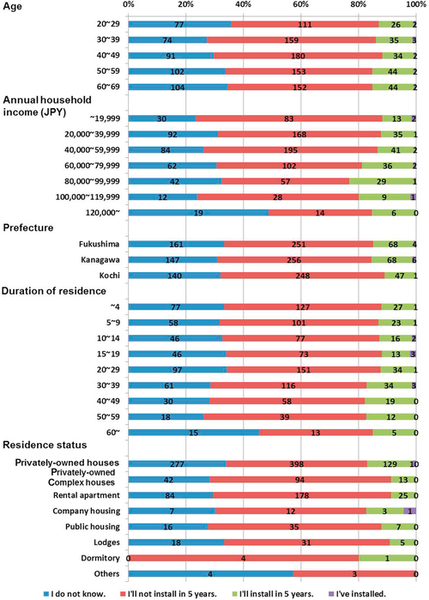
Storage battery ownership is uniformly distributed across each generation (age) and duration of residence. However, annual household income and residence status show significant differences. Groups whose annual household income is more than JPY 10,000,000 (about $100,000 if $1 = JPY 100) show a slight decrease in purchase intentions, though higher household income may be linked to ESS installations. In addition, only owners of private houses have installed systems as of yet, though some respondents representing other residence status groups are planning to install a system.
In terms of residential area, we could not find significant differences between Fukushima and Kanagawa prefectures; however, people living in Kochi prefecture have a relatively low motivation to install ESS in their homes.
12.5 Conclusion
While consumer perceptions of and attitudes toward residential PV systems are positive and growing, they may not be well informed about the true costs when the system fails. This is especially important for system owners. The perceptions and attitudes related to ESS are still in the early stage and are thus weak. We cannot confirm any significant difference based on consumers’ ages; however, there are differences based on annual household income and residence status. After all, the system is expensive, so it is appealing for limited groups of people. The results of the surveys in this chapter also indicate that many current residential PV owners are interested in a storage system, and thus the combination of the two systems could become something like “bread and butter” in the future. Given the current FiT scheme in Japan, there is growing criticism pointing out a potential market bubble for residential PV systems. In addition, the financial burden on the general public to maintain the scheme could become socially and politically unacceptable in the near future. Therefore, providing more reliable information about the merits and demerits of electricity storage systems is crucial to shaping consumers’ perceptions and attitudes.
